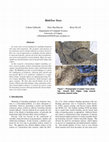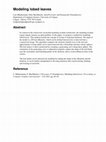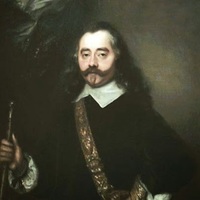Papers by Peter MacMurchy

In recent years several methods for modeling botanical trees have been proposed. The geometry and... more In recent years several methods for modeling botanical trees have been proposed. The geometry and topology of tree skeletons can be well described by L-systems; however, there are several approaches to modeling smooth surfaces to represent branches, and not all of the observed phenomena can be represented by current methods. Many tree types exhibit non-smooth features such as branch bark ridges and collars. In this research a hierarchical implicit modeling system is used to produce models of branching structures that capture smooth branching, branch collars and branch bark ridges. The BlobTree provides several techniques to control the combination of primitives, allowing both smooth and non-smooth effects to be intuitively combined in a single blend volume. Irregular effects are implemented using Precise Contact Modeling, Constructive Solid Geometry and space warping. We show that smooth blends can be obtained, without noticeable bulging, using summation of distance based implicit s...

In contrast to the extensively researched modeling of plant architecture, the modeling of plant o... more In contrast to the extensively researched modeling of plant architecture, the modeling of plant organs largely remains an open problem. In this paper, we propose a method for modeling lobed leaves. This method extends the concept of sweeps to branched skeletons. The input of the model is a 2D leaf silhouette, which can be defined interactively or derived from a scanned leaf image. The algorithm computes the skeleton (medial axis) of the leaf and approximates it using spline curves interconnected into a branching structure (sticky splines). The leaf surface is then constructed by sweeping a generating curve along these splines. The orientation of the generating curve is adjusted to properly capture the shape of the leaf blade near the extremities and branching points of the skeleton, and to avoid selfintersections of the surface. The leaf model can be interactively modified by editing the shape of the silhouette and the skeleton. It can be further manipulated in 3D using functions th...
Proceedings Computer Graphics International 2003, 2003
In contrast to the extensively researched modeling of plant architecture, the modeling of plant o... more In contrast to the extensively researched modeling of plant architecture, the modeling of plant organs largely re-mains an open problem. In this paper, we propose a method for modeling lobed leaves. This method extends the concept of sweeps to branched skeletons. The ...
Visualization of data via 3D spherical layouts are popular with many examples. Sphere layouts sho... more Visualization of data via 3D spherical layouts are popular with many examples. Sphere layouts should balance issues such as occlusion, backside visibility and potentially more complex interaction models against potential useful benefits such as natural navigational affordances, topological wraparaound, circular aesthetics and perceptual connotations of an application.
2012 16th International Conference on Information Visualisation, 2012
ABSTRACT Use of a sphere as a basis for organizing an information visualization should balance is... more ABSTRACT Use of a sphere as a basis for organizing an information visualization should balance issues such as occlusion against potential useful benefits such as natural navigational affordances and perceptual connotations of an application.
Computer Graphics …, Jan 1, 2003
In contrast to the extensively researched modeling of plant architecture, the modeling of plant o... more In contrast to the extensively researched modeling of plant architecture, the modeling of plant organs largely remains an open problem. In this paper, we propose a method for modeling lobed leaves. This method extends the concept of sweeps to branched skeletons. The input of the model is a 2D leaf silhouette, which can be defined interactively or derived from a scanned leaf image. The algorithm computes the skeleton (medial axis) of the leaf and approximates it using spline curves interconnected into a branching structure (sticky splines). The leaf surface is then constructed by sweeping a generating curve along these splines. The orientation of the generating curve is adjusted to properly capture the shape of the leaf blade near the extremities and branching points of the skeleton, and to avoid selfintersections of the surface.
In recent years several methods for modeling botanical trees have been proposed. The geometry and... more In recent years several methods for modeling botanical trees have been proposed. The geometry and topology of tree skeletons can be well described by L-systems; however, there are several approaches to modeling smooth surfaces to represent branches, and not all of the observed phenomena can be represented by current methods. Many tree types exhibit non-smooth features such as branch bark ridges and collars.
Plants and plant organs are commonly modeled using skeletal techniques. Plant structure is then d... more Plants and plant organs are commonly modeled using skeletal techniques. Plant structure is then described in terms of axes, around which limb surfaces are built using standard geometric modeling techniques, such as generalized cylinders or implicit surfaces. In this research, an alternative, based on the use of subdivision techniques, is described. The approach is to build a simple polygon mesh around the skeleton and use a surface subdivision algorithm to get a smooth surface. Special attention is given to the modeling of surfaces surrounding branching points. It is shown that subdivision surfaces provide a useful alternative to approaches based on implicit surfaces. The method is illustrated using models of tree branches and compound leaves.
Proceedings ofComputer Graphics …, Jan 1, 2003
In contrast to the extensively researched modeling of plant architecture, the modeling of plant o... more In contrast to the extensively researched modeling of plant architecture, the modeling of plant organs largely remains an open problem. In this paper, we propose a method for modeling lobed leaves. This method extends the concept of sweeps to branched skeletons. The input of the model is a 2D leaf silhouette, which can be defined interactively or derived from a scanned leaf image. The algorithm computes the skeleton (medial axis) of the leaf and approximates it using spline curves interconnected into a branching structure (sticky splines). The leaf surface is then constructed by sweeping a generating curve along these splines. The orientation of the generating curve is adjusted to properly capture the shape of the leaf blade near the extremities and branching points of the skeleton, and to avoid selfintersections of the surface.
Methods in non-photorealistic graphics have tended to place emphasis on algorithms, instead of ar... more Methods in non-photorealistic graphics have tended to place emphasis on algorithms, instead of artists. In contrast, we present a conceptual framework that has been designed to put the control back in the hands of the artist. Combining ideas from nonphotorealistic graphics and artificial intelligence, we examine a new method of supporting alternative artistic styles. The details of this model are described using displays based on stylised wave patterns called "seigaiha" in Japanese. In keeping with the Japanese style we provide interactive access to alternate styles of perspective. Finally, we animate our images within this framework, presenting flickerfree non-photorealistic animation.
Plants and plant organs are commonly modeled using skeletal techniques. Plant structure is then d... more Plants and plant organs are commonly modeled using skeletal techniques. Plant structure is then described in terms of axes, around which limb surfaces are built using standard geometric modeling techniques, such as generalized cylinders or implicit surfaces. In this research, an alternative, based on the use of subdivision techniques, is described. The approach is to build a simple polygon mesh around the skeleton and use a surface subdivision algorithm to get a smooth surface. Special attention is given to the modeling of surfaces surrounding branching points. It is shown that subdivision surfaces provide a useful alternative to approaches based on implicit surfaces. The method is illustrated using models of tree branches and compound leaves.







Uploads
Papers by Peter MacMurchy